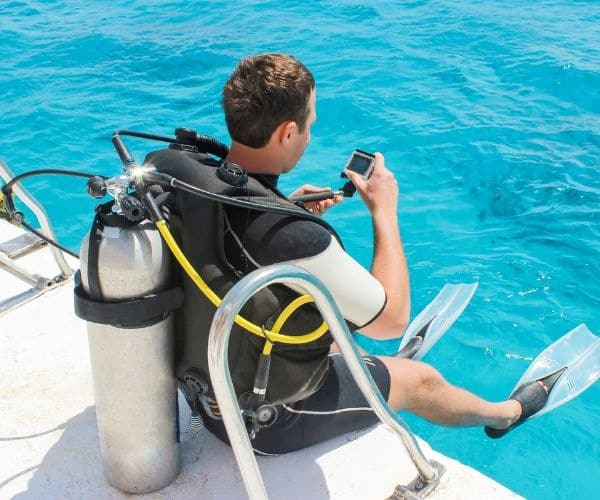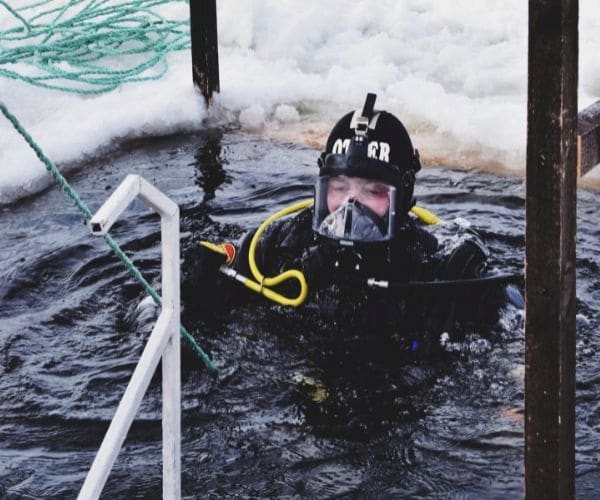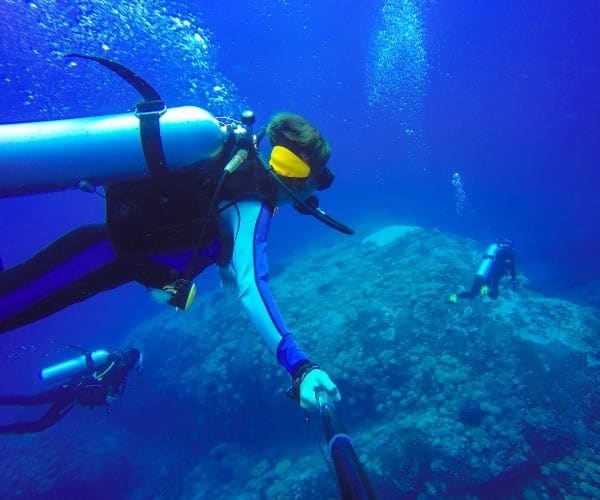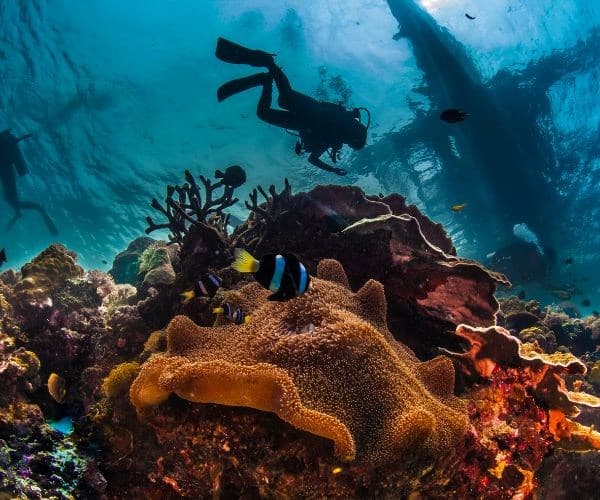When most people picture scuba diving, they imagine warm tropical seas: sunshine, colourful reefs, and schools of bright fish drifting through crystal-clear water. But not all diving happens under a blazing sun. Some of the world’s most spectacular underwater experiences lie hidden in cold seas, beneath kelp forests, ice shelves, and along rugged northern coastlines.
Diving in cold water and hot water are two very different experiences, each with unique challenges and rewards. From the equipment you’ll need, to the preparation required, to the safety considerations in each environment, this guide explores everything you need to know to decide which type of diving is right for you, or whether you might want to try both.
Warm water diving: the classic scuba experience

For many divers, warm water destinations are where their love of the sport begins. Tropical seas offer comfort, ease, and vibrant marine life, making them an ideal environment for beginners as well as seasoned divers seeking relaxation.
Popular destinations include the Caribbean, the Maldives, Southeast Asia, the Red Sea, and the Pacific islands. These regions are famous for their calm seas, gentle currents, and excellent visibility. On a good day, you can see more than 30 meters ahead, which makes navigating the reef and spotting wildlife effortless.
The marine life here is equally dazzling: colourful parrotfish, reef sharks, turtles, manta rays, and delicate corals that form entire underwater cities. Warm water diving also has a certain “holiday vibe” to it – surface intervals spent on sandy beaches or tropical boats are a big part of the appeal.
Gear and equipment for warm waters
One of the main reasons warm water diving feels easier is the minimal gear required. Most divers are comfortable in a thin wetsuit (3mm) or even just a rash guard. Gloves, hoods, and boots are often unnecessary, and regulators don’t need special adaptations. The result is lighter packing, less bulk, and a generally more comfortable dive.
That doesn’t mean gear isn’t important, though. A well-fitting mask, buoyancy control device (BCD), and fins still make all the difference in your dive experience. If you’re new to diving and wondering what kit to prioritise, this scuba diving equipment guide is a great place to start.
Risks of warm water diving
Although warm water is often seen as “easy diving,” there are still risks to consider:
- Dehydration is common in hot climates, especially when divers spend long days in the sun.
- Sunburn during surface intervals can be more uncomfortable than the dive itself if you don’t apply reef-safe sunscreen.
- Coral cuts and jellyfish stings are hazards if you aren’t careful with your buoyancy or drift into the reef.
- Crowded dive sites can sometimes lead to accidents if divers don’t maintain awareness.
These risks are manageable, and for most people, warm water remains the most comfortable and inviting way to dive.
Cold water diving: adventure beneath the surface

Cold water diving is often thought of as the domain of “hardcore” divers, but that perception doesn’t do it justice. While it’s true that diving in cooler seas requires more preparation, it also offers access to breathtaking environments that few people ever get to see.
Imagine gliding through a towering kelp forest, shafts of light cutting down through the swaying plants like an underwater cathedral. Or descending into icy polar waters where visibility is so clear it feels like floating through air. Or exploring a centuries-old shipwreck, preserved by cold conditions. These are the kinds of experiences that make cold water diving unforgettable.
Common destinations include the fjords of Norway, the kelp forests of California, British Columbia in Canada, New Zealand’s South Island, and even Antarctic expeditions.
Can you really dive in cold water?
Yes – absolutely. With the right equipment and training, diving in cold water is not only possible but often more rewarding than warm water diving. It does take some adaptation, especially when it comes to gear, but thousands of divers around the world enjoy these environments year-round.
Gear and equipment for cold waters
Where warm water divers can get away with minimal gear, cold water divers must be well-prepared. At the very least, a thick wetsuit (7mm) is required, but most divers prefer a drysuit. Unlike wetsuits, drysuits keep water out entirely, insulating you with thermal layers worn underneath.
Other essentials include:
- A hood, gloves, and boots to prevent heat loss through your extremities.
- A cold-water regulator, which is specially designed to avoid freezing at low temperatures.
- Extra weights, since drysuits add buoyancy and need to be offset.
Learning to dive in a drysuit takes training, and most dive agencies offer a specialty course. Once you’ve completed it, however, you’ll find that cold water diving feels much more approachable.
Risks of cold water diving
Cold environments come with challenges:
Hypothermia is the biggest concern if exposure protection fails.
Thick gloves reduce dexterity, making tasks like adjusting gear more difficult.
Regulators can freeze in near-zero water temperatures, causing free-flow.
Strong currents and difficult entries/exits can add complexity.
Preparation and awareness are the keys to staying safe. For divers looking to improve their skills, practicing in varying conditions and reading resources like this guide on diving in currents can help build confidence.
What do you need to dive in different waters?
While the fundamentals of scuba gear remain consistent, exposure protection is the main difference.
Feature | Warm Water (24–30°C) | Cold Water (0–15°C) |
Exposure Protection | Rash guard or 3mm wetsuit | 7mm wetsuit or drysuit |
Hood, Gloves, Boots | Rarely needed | Essential |
Regulator | Standard | Cold-water rated |
Weights | Lighter setup | Heavier (to offset drysuit) |
Comfort Factor | Easier for beginners | Demands more stamina and prep |
In warm water, divers worry more about sun protection and hydration. In cold water, the priority is maintaining body temperature and managing bulky gear.
Risks and safety in hot vs. cold water

All forms of diving carry risks, but the nature of those risks varies with water temperature.
Warm water risks are often external: coral scrapes, jellyfish, dehydration, or poor awareness in busy sites. Cold water risks tend to be physiological: hypothermia, reduced dexterity, regulator malfunction.
The good news is that with proper preparation, both environments are safe and enjoyable. Training, fitness, and familiarity with your gear all make a huge difference.
Preparation: setting yourself up for success
Regardless of whether you’re diving in hot or cold water, preparation is key. Here are some universal tips:
Get the right training. Beginners will thrive in warm water, but cold-water diving may require specialty certifications like drysuit training.
Test your equipment. Regulators, wetsuits, and drysuits should be checked before every dive. Cold water divers in particular, must ensure seals and valves are functioning.
Plan for the environment. In tropical waters, plan your dives around currents and avoid damaging coral. In cold water, study entry/exit points carefully.
Listen to your body.
If you feel cold, fatigued, or anxious, it’s better to cut a dive short than risk safety.
Which should you choose?

If you’re just starting out, warm water diving is the easiest and most comfortable way to explore the underwater world. The gear is lighter, the conditions are friendlier, and the marine life is dazzling.
But if you’re looking for adventure, cold water diving opens the door to experiences you simply can’t find in the tropics: close encounters with seals, kelp forests that feel like alien landscapes, or ice dives under crystal-clear frozen seas.
The best divers don’t choose one or the other – they embrace both. Warm water diving offers the classic beauty of coral reefs, while cold water diving gives you the thrill of exploration and the sense of being part of something fewer people experience.
Final thoughts
Scuba diving is as diverse as the oceans themselves. Whether you’re floating above a coral reef in the Maldives or exploring a shipwreck in British Columbia, each environment offers something unique. Warm water diving may be easier and more accessible, but cold water diving can be deeply rewarding for those who prepare properly.
Ultimately, it isn’t about choosing cold over hot – it’s about discovering the best of both worlds. Equip yourself with the right gear, take the necessary safety precautions, and stay open to adventure. The ocean, in all its temperatures, is waiting.
Protect your scuba adventures with the right insurance
Whether you’re drifting above a tropical reef or exploring the mysteries of cold northern seas, every dive comes with its own risks. Having the right protection means you can focus on the experience, not the what-ifs.
SportsCover Direct’s Scuba Diving Travel Insurance is built specifically for divers, with cover that includes worldwide protection, emergency medical support, trip cancellations, cover for existing medical conditions, and dives down to 40 metres or more.
Choose from single-trip or annual multi-trip policies tailored to your itinerary and level of experience. So wherever your next dive takes you – from sunlit shallows to icy depths – you’ll have peace of mind knowing you’re protected.
Get a personalised quote today.
This blog has been created as general information and should not be taken as advice. Make sure you have the correct level of insurance for your requirements and always review policy documentation.